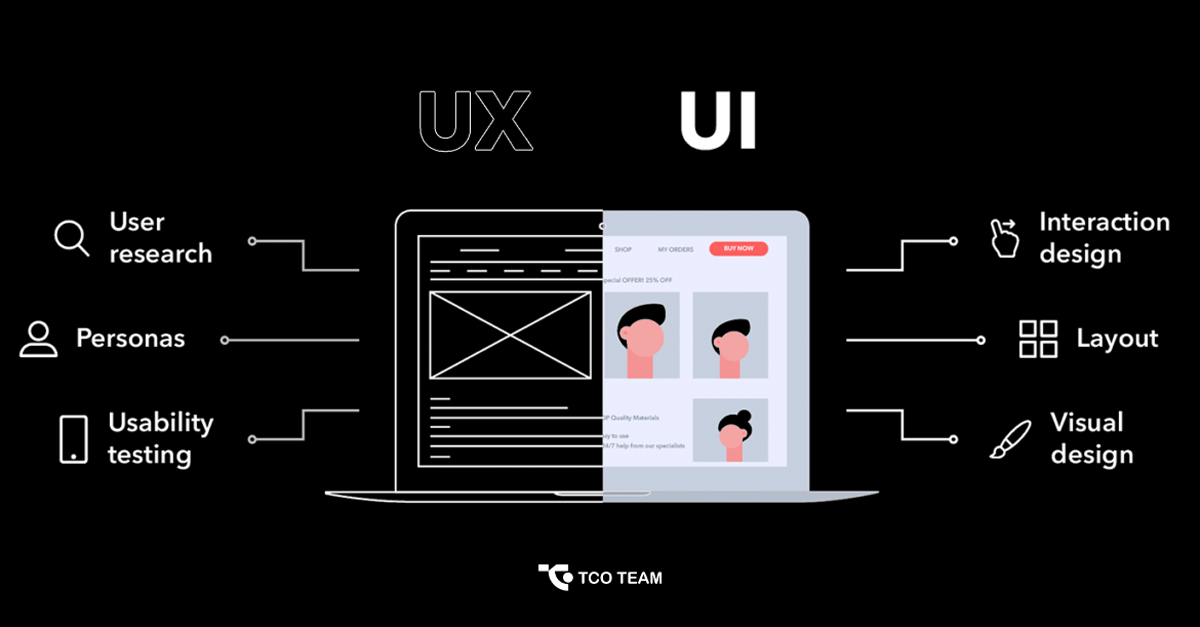UI vs UX

UI/UX stands for User interface and User experience. It is a crucial component of every website and mobile app. Because UI/UX places a great emphasis on user satisfaction, it might impact whether or not people will use your services. A great UI/UX design will increase customer retention, sales, and conversions and attract additional prospects. Both UI and UX designers aim to develop user-friendly “systems.”
UI design and UX design are two of the most frequently misunderstood and muddled phrases in web and app design. User interface (UI) is merely the visible portion of the iceberg; user experience (UX) is the hidden portion that users may not even be aware of.
What is UI (User Interface)?
User interface (UI) is the visual component that people interact with when using a website, app, or other electronic devices. This covers every single micro-interaction, as well as screen layout, transitions, and interface animations. Design is required for every visual component, interactive feature, and animation.
The task here belongs to UI designers. They care about appearance, and it is their responsibility to ensure that the application’s user interface is appealing, aesthetically pleasing, and consistent with the brand of the company. They choose how the application will be designed. They must decide on color schemes, line and button widths, button designs, and text fonts.
There are many different kinds of user interface (UI) design, including graphical user interface (GUI), command line interface (CLI), touch user interface, game UI, and even voice user interface (VUI).
- Graphical user interface (GUI) and command line interface (CLI)
GUIs offer a visual means of interacting with software and operating systems without needing to see the underlying code or skeleton. Contrarily, command line interfaces (CLI) entail the use of text-only command windows like Linux’s terminal or Windows Powershell.
- Game UI
The goal of game UI is to give the user enough info and feedback so they can quickly and easily understand the game’s current state. To complete their gaming objectives, players shouldn’t be required to gaze at crowded interfaces or explore complicated menus.
- Voice UI
VUI is an excellent technique to add interaction for people with poor vision or limited mobility. It is an area that is expanding as more products and software are becoming voice-activated. An example of VUI is Apple’s Siri.
- Touch UI
Touch UI refers to how we interact with touch-based gadgets like our smartphones and tablets. For interactivity, these gadgets make use of hand gestures, long pushes, swipes, and touches.
Skills for UI designers:
- Design concepts for interactions
- Typography, color theory, and branding
- Prototyping and wireframing
- Style manuals
- Personas and user research
- Collaboration and communication abilities
- Essential tools for the industry, such as Sketch
UI is essential since, without appealing aesthetics and a focus on good UI design, your product’s effectiveness, design, and even your business may suffer from users switching to competitors’ goods and websites because they have greater interactivity.
What is UX (User Experience)?
UX is more broadly concerned with a user’s whole experience with a brand, product, or service. The ease or difficulty of interacting with the user interface elements that the UI designers have built determines the user experience (UX).
Therefore, UX designers are equally concerned with the user interface of an application, which is why some people are unclear about the distinction between the two. However, UX designers are in charge of deciding how the user interface will function, whereas UI designers are responsible for deciding how the user interface will look. UX designers decide how the interface is organized, how it functions, how everything is put together, and how each component relates to the others. In a word, they create the interface’s functionality.
UX design has three core specialties: Interaction Design (IxD), User Research (UR), Information Architecture (IA), and Experience Strategy (ExS).
- Information Architecture (IA)
The discipline of organizing data and material in a relevant and approachable manner is known as information architecture. This is essential for assisting the consumer in navigating a product. Information architects take into account the relationships between various kinds of content while determining the IA of any given product. Additionally, they focus on the language being utilized and make sure that it is persuasive and consistent.
- Experience Strategy (ExS)
The goal of experience strategy is to create a comprehensive business plan that takes into account both the demands of the organization and the customers.
- User Research (UR)
In order to comprehend the demands and goals of the end user, UX designers will launch surveys, carry out usability testing, and construct user personas. To make wise design decisions, designers collect both qualitative and quantitative data.
- Interaction Design (IxD)
All interactive features, including buttons, page transitions, and animations, are considered while designing interaction with a system. Interaction designers aim to produce straightforward designs that make it simple for users to carry out essential jobs and behaviors.
Skills for UX designers:
- Research
- Information Architecture
- Wireframing
- Prototyping
- Visual Communication, which includes:
- Layout
- Color
- Typography
- Icons
- Images
- Design Theory
Some Benefits of good UI/UX design
- Increased ROI
An expert team of UI/UX designers should make sure to produce UI/UX app designs that result in revenue. These designers conduct experiments to determine what appeals to customers the most, and they then adjust the experience accordingly. They increase earnings by putting into action the best strategy.
- Improved Brand Awareness
These days, it is more probable that your software will go unnoticed if it is plain and dull. As a result, having a distinctive and appealing UI/UX design will help you stand out from others and increase brand awareness.
- Higher User Acquisition/Retention
Gaining and retaining users requires a lot of preparation and strategy. A better user experience and interface will make the app easy to draw in and keep users. UI/UX designers assess every area of your app, create a workable plan for acquiring and retaining users, optimize the app’s look and feel, and maintain the users’ satisfaction.
- Improved Usability and Accessibility
UI/UX designers improve the customer experience by ensuring that your app is practical and user-friendly. With carefully chosen and considered features and color palettes that have positive emotional resonance, it enhances the entire experience. Attention-to-detail UI/UX designers will increase usability and accessibility.

